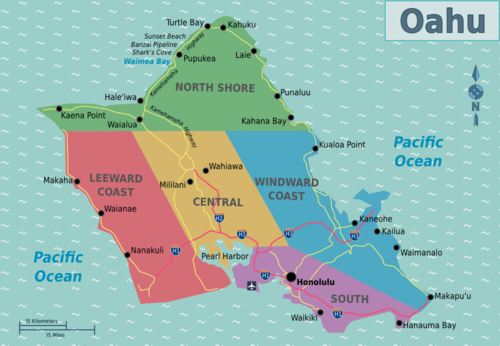Introduction
Oahu, the third largest of the Hawaiian Islands, is a captivating destination known for its stunning natural beauty, rich cultural heritage, and diverse landscapes. With an area of approximately 597 square miles (1,545 square kilometers), Oahu may be small in size compared to some of its fellow islands, but it packs a punch when it comes to the variety of experiences it offers. From the bustling city life of Honolulu to the serene beauty of its beaches and mountains, Oahu is a true gem in the heart of the Pacific Ocean.
The Size of Oahu
Oahu spans an area of approximately 597 square miles (1,545 square kilometers), making it the third largest of the Hawaiian Islands. Despite its modest size, Oahu is home to nearly 900,000 people, accounting for about 70% of Hawaii’s total population. The island is 44 miles (71 km) long and 30 miles (48 km) across, with a shoreline that stretches 227 miles (365 km). Oahu’s size may be smaller than the Big Island and Maui, but it is still larger than the famous metropolis of New York City, which covers about 302 square miles.
Oahu’s Geography
Oahu is composed of two separate shield volcanoes: the Waiʻanae Range in the west and the Koʻolau Range in the east. The highest point on the island is Kaʻala in the Waiʻanae Range, rising to 4,003 feet (1,220 m) above sea level. The central part of the island is dominated by the flat Leilehua Plateau, while the southeastern portion features volcanic craters like Diamond Head, Koko Head, and Punchbowl.The island’s asymmetrical butterfly shape is a result of these geological features, creating a diverse array of landscapes that captivate visitors from around the world. From the azure waters of Waikiki Beach to the lush rainforests of the Koʻolau Mountains, Oahu offers a wealth of natural wonders to explore.
Regions of Oahu
Oahu can be divided into several distinct regions, each with its own unique character and attractions:
Honolulu and Waikiki
Honolulu, the state capital and largest city on Oahu, is located on the island’s southeastern coast. It is home to the famous Waikiki Beach, a bustling hub of hotels, restaurants, and shopping. Honolulu is also the main financial and cultural center of Hawaii, with attractions like the Iolani Palace, the only royal palace in the United States.
North Shore
The North Shore of Oahu is renowned for its world-class surfing, with legendary waves attracting surfers from across the globe. Home to the famous Banzai Pipeline and Sunset Beach, surf enthusiasts flock here, especially during winter months when the swells are most formidable. Beyond the surf, the North Shore offers a laid-back atmosphere and miles of pristine beaches.
Windward Coast
The eastern, or windward, coast of Oahu is hemmed in by the gorgeous Koʻolau Mountain Range and boasts some of the island’s best beaches. This region offers a more tranquil escape from the bustling Waikiki scene, with quaint towns dotting the coastline. The Ka’a’awa Valley, easily recognizable as the backdrop for the hit television series “Lost,” is also located on this side of the island.
Central Oahu
Central Oahu is where a large portion of the island’s residents live. While it may not have the same tourist appeal as other regions, this area is home to several important landmarks, including Pearl Harbor and the Dole Pineapple Plantation.
Recommended Length of Stay
The ideal length of a visit to Oahu can vary depending on personal interests and travel preferences. For those focused on city life and attractions, a few days might suffice. However, nature enthusiasts and culture seekers may desire a longer stay to fully explore the island’s diverse landscapes and engage with its rich cultural heritage.A minimum recommended stay of at least 5 days allows for a leisurely pace to experience historical sites, natural wonders, and recreational activities without feeling rushed. For those intrigued by Oahu’s beauty but unsure where to start, carefully crafted itineraries can provide inspiration and guidance.
Getting Around Oahu
Oahu offers a variety of transportation options to help visitors navigate the island:
- Driving: Renting a car is a popular choice, as it provides flexibility and the ability to explore at your own pace. The island’s main highways, H-1 and H-2, connect the major regions.
- Public Transportation: TheBus system provides an affordable and convenient way to get around, with routes connecting Honolulu to other parts of the island.
- Taxis and Rideshares: Taxis and services like Uber and Lyft are readily available, especially in the Honolulu and Waikiki areas.
- Guided Tours: For a more structured experience, guided tours offer the opportunity to explore the island with knowledgeable local guides. These tours often include transportation and can be tailored to specific interests.
Oahu’s Attractions and Activities
Oahu offers a diverse array of attractions and activities to suit every interest:
- Beaches: From the iconic Waikiki Beach to the secluded coves of the Windward Coast, Oahu boasts some of the most beautiful beaches in the world.
- Hiking: The island’s lush landscapes are perfect for hiking, with trails ranging from easy coastal walks to challenging mountain treks.
- Water Sports: Oahu is a paradise for water sports enthusiasts, with opportunities for surfing, snorkeling, scuba diving, and stand-up paddleboarding.
- Cultural Attractions: Oahu is rich in history and culture, with sites like Pearl Harbor, the Iolani Palace, and the Bishop Museum offering insights into the island’s past.
- Shopping and Dining: Oahu is a shopper’s and foodie’s delight, with a wide range of shopping options and a diverse culinary scene that showcases the best of Hawaiian and international cuisine.
FAQ
How big is Oahu compared to other Hawaiian Islands?
Oahu is the third largest of the Hawaiian Islands, spanning an area of approximately 597 square miles (1,545 square kilometers). It is smaller than the Big Island and Maui but larger than Kauai and Molokai.
What is the population of Oahu?
As of 2021, Oahu had a population of 995,638, accounting for approximately 70% of Hawaii’s total population. The majority of residents live in or near the Honolulu urban area.
What is the climate like on Oahu?
Oahu enjoys a tropical climate with warm temperatures year-round. The average temperature ranges from 70-85°F (21-29°C), with the warmest months being June through October. The winter months are slightly cooler but still warm, with average temperatures of 68-78°F (20-26°C).
What are some of Oahu’s most famous landmarks?
Some of Oahu’s most famous landmarks include Waikiki Beach, Diamond Head, Pearl Harbor, the Iolani Palace, and the North Shore’s surfing beaches like Banzai Pipeline and Sunset Beach.
How long should I plan to stay on Oahu?
The ideal length of stay on Oahu depends on your interests and travel style. A minimum of 5 days is recommended to experience the island’s main attractions and activities at a leisurely pace. However, those interested in a more immersive experience may want to stay longer to fully explore Oahu’s diverse regions and cultural offerings.
Conclusion
Oahu, the “Gathering Place,” is a captivating island that offers a perfect blend of natural beauty, cultural richness, and modern amenities. Despite its modest size, Oahu packs a punch when it comes to the variety of experiences it offers. From the bustling city life of Honolulu to the serene beauty of its beaches and mountains, Oahu is a true gem in the heart of the Pacific Ocean. Whether you’re seeking adventure, relaxation, or a deeper connection with Hawaiian culture, Oahu is a destination that will leave a lasting impression on your heart and mind.
Information in Table
| Characteristic | Value |
|---|---|
| Area | 597 square miles (1,545 square kilometers) |
| Length | 44 miles (71 km) |
| Width | 30 miles (48 km) |
| Shoreline | 227 miles (365 km) |
| Highest Point | Kaʻala in the Waiʻanae Range, 4,003 feet (1,220 m) above sea level |
| Population | 995,638 (as of 2021) |
For more information on Oahu’s geography and statistics, please refer to the Wikipedia article on Oahu.



